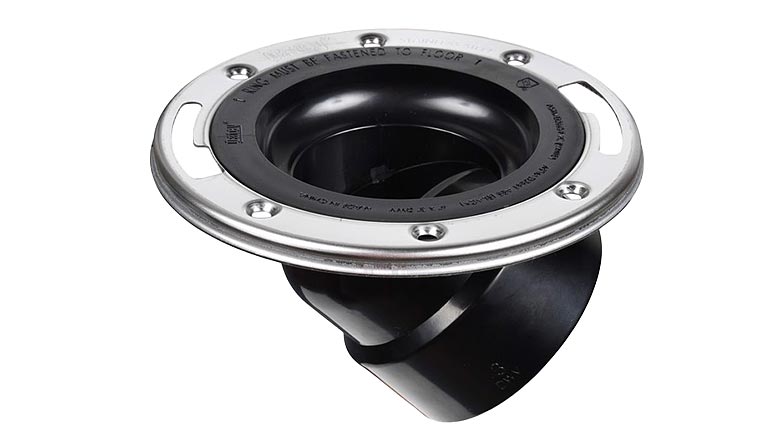This article on the next paragraphs involving Fix a Broken Toilet Flange is without a doubt intriguing. Read it for yourself and figure out what you think about it.

Intro:
Recognizing the Importance of a Toilet Flange:
In the world of plumbing, the often-overlooked toilet flange plays an essential duty in ensuring the smooth operation of your shower room fixtures. As an important adapter in between your toilet and the underlying waste pipe, the commode flange functions as the unrecognized hero of your plumbing system. Without this strong element, your bathroom would be prone to instability and leaks, potentially causing pricey repair work and trouble. Consequently, comprehending the relevance of an effectively set up and maintained commode flange is critical for any property owner starting plumbing jobs or resolving repair service demands.
Why Proper Installation and Maintenance Matter:
Correct setup and careful maintenance of the toilet flange are essential for protecting the stability of your plumbing infrastructure. A diligently mounted flange not only supports your commode safely in position however also forms an impervious seal, preventing the hazards of leaks and smells. By embracing a proactive strategy to flange upkeep, you can alleviate the danger of disruptive plumbing problems and preserve the tranquillity of your home setting. Throughout this insightful overview, we'll unravel the details of toilet flange installment and repair service, encouraging you with the understanding and proficiency to navigate these vital tasks adeptly.
Best Practices When Installing a Toilet Flange:
Ensuring a seamless toilet flange setup needs adherence to a set of ideal practices that ensure longevity and functionality. Begin by carefully examining your devices and materials, ensuring you have the required equipment for the task in advance. Picking the appropriate flange material, whether PVC, ABS, or cast iron, is critical, as it establishes the long life and performance of your plumbing fixture. Moreover, assessing existing plumbing problems, such as looking for damage or deterioration, is crucial for preemptively resolving prospective issues and guaranteeing a smooth setup process. By adopting these primary procedures, you set a solid foundation for a successful bathroom flange installation, reducing the chance of future problems and assisting in lasting maintenance.
Once sufficiently ready, wage the mindful removal of the old flange, following an organized method to avoid triggering damages to surrounding components. Employ strategies tailored to address persistent or rusted flanges, guaranteeing their swift and risk-free removal without compromising the integrity of the bordering plumbing facilities. With the old flange eliminated, meticulously install the brand-new substitute flange, selecting one that fits snugly and safely right into location. Correctly safeguarding the flange to the flooring using screws or adhesive is critical, as it ensures security and avoids future leakages. By sticking to these finest techniques throughout the installation process, you prepared for a durable and dependable toilet flange configuration that holds up against the test of time.
Installing a New Toilet Flange:
When setting up a new toilet flange, the first step is to choose the right replacement for your plumbing arrangement. Take into consideration variables such as the product of the flange, with alternatives including PVC, ABS, or cast iron. PVC flanges are known for their affordability and resistance to deterioration, making them a preferred option for DIY enthusiasts. Abdominal muscle flanges use comparable benefits to PVC but brag added durability, making them ideal for high-traffic areas or business setups. Cast iron flanges, renowned for their strength and longevity, are optimal for setups where toughness is paramount. In addition, make sure that the replacement flange is correctly sized and fits well right into area to develop a watertight seal and protect against leaks.
Safeguarding the Flange to the Floor:
Once you've picked the ideal replacement flange, it's vital to secure it properly to the flooring to make certain security and prevent future concerns. Begin by placing and straightening the flange properly over the waste pipe, making sure that it sits flush with the floor surface. Depending upon the kind of flange and your particular installation choices, you can protect the flange to the flooring making use of screws or sticky. If making use of screws, make sure to use corrosion-resistant choices to prevent rusting with time. Additionally, adhesive can give a safe bond in between the flange and the flooring, guaranteeing a tough and trustworthy installation. By complying with these actions and taking the essential precautions, you can install a new commode flange with self-confidence, ensuring a resilient and leak-free plumbing fixture.
Ideal Practices When Repairing a Broken Flange:
Fixing a broken bathroom flange demands thorough focus to detail and adherence to ideal methods to ensure an enduring solution. Begin by thoroughly assessing the extent of the damage and determining the underlying cause, whether it be corrosion, cracks, or imbalance. This analysis will certainly direct your fixing method, allowing you to pick the most appropriate methods and materials for bring back the flange to its ideal condition. In addition, think about the bordering plumbing infrastructure and floor security to deal with any type of prospective adding factors and avoid future issues from emerging. By conducting a detailed analysis and evaluation, you lay the groundwork for an efficient and long-lasting fixing procedure that resolves the root cause of the problem.
With a clear understanding of the flange's condition and the aspects affecting its damage, proceed with the repair work procedure using accuracy and care. Depending upon the severity of the damages, you may opt for repair approaches such as epoxy putty, repair work flange kits, or partial flange substitutes. Make sure that the selected repair work technique effectively addresses the details issues at hand while preserving the architectural integrity and capability of the flange. Furthermore, take proactive actions to reinforce the repaired flange and avoid future damage, such as applying sealer or waterproofing materials to protect against leaks and corrosion. By sticking to these best methods during the repair procedure, you can recover your broken flange to optimal problem, making sure the long-lasting reliability and efficiency of your plumbing system.
Kinds Of Toilet Flanges:
Understanding the numerous kinds of toilet flanges is essential for choosing one of the most suitable choice for your plumbing needs. PVC, ABS, and cast iron are among the usual materials utilized in toilet flange building, each offering distinctive advantages and factors to consider. PVC flanges, recognized for their cost and rust resistance, are favoured for their convenience of installment and toughness. ABS flanges, comparable to PVC in regards to price and convenience of installment, are valued for their effectiveness and resistance to impacts. On the other hand, cast iron flanges, renowned for their extraordinary stamina and longevity, are commonly liked for high-traffic locations or commercial settings where toughness is vital. By acquainting yourself with the features of each product, you can make a notified choice when picking a bathroom flange that straightens with your details needs and choices.
In addition to material factors to consider, toilet flanges also are available in various design and styles to accommodate various plumbing configurations and installment preferences. Offset flanges, for example, are designed to fit bathrooms mounted on floorings that are uneven or where the waste pipe lies off-centre. Similarly, repair service flanges, additionally called repair service rings or spacer rings, are used to resolve concerns such as broken or damaged flanges without the need for considerable plumbing modifications. Additionally, adjustable flanges provide versatility in positioning, allowing for accurate alignment and fit during installation. By discovering the diverse variety of toilet flange kinds and styles offered, you can select the option that ideal fits your plumbing setup and installation needs, making sure a seamless and reliable remedy for your restroom components.
Specialty Options:
Along with traditional bathroom flanges, there are specialty choices readily available to deal with details plumbing challenges and setup preferences. One such alternative is the offset flange, which is developed to fit commodes mounted on floors that are not level or where the waste pipe lies off-centre. Countered flanges include an unique design that allows the toilet to be positioned at a small angle, compensating for unequal floor covering or misaligned plumbing links. This cutting-edge remedy makes certain a safe and secure and secure installation, eliminating the need for expensive and taxing floor progressing or pipeline moving. By including an offset flange into your plumbing configuration, you can conquer typical setup barriers and attain a professional-quality result effortlessly.
An additional specialized alternative worth taking into consideration is the repair service flange, additionally called a repair work ring or spacer ring. Repair flanges are especially made to attend to issues such as split or broken bathroom flanges without the requirement for substantial plumbing adjustments. These flexible elements can be mounted straight over the existing flange, supplying a tough and reputable base for safeguarding the commode in position. Repair flanges can be found in numerous dimensions and arrangements to fit different flange diameters and installation requirements, making them a hassle-free and cost-efficient option for solving flange-related issues. Whether you're taking care of a small flange repair service or a much more complex plumbing concern, integrating specialized choices like offset and repair service flanges can streamline the installation process and make certain resilient performance for your shower room components.
Final thought:
In conclusion, mastering the art of toilet flange setup and repair is vital for preserving a functional and leak-free plumbing system in your home. By comprehending the relevance of an effectively set up flange and sticking to finest techniques throughout the process, you can make certain the long life and reliability of your bathroom components. Whether you're picking the appropriate type of flange, performing repairs, or discovering specialized choices, interest to detail and meticulous implementation are vital. Routine maintenance and aggressive fixing can help prevent costly plumbing issues and maintain the serenity of your household setting. Armed with the expertise and skills obtained from this detailed guide, you can deal with commode flange setup and fixing with confidence, equipping you to guard your plumbing system for many years ahead.
How to Install a Toilet Flange on A Concrete Floor
Preparation in Installing or Replacing a Toilet Flange
Gloves Screwdriver Hacksaw or a power saw Measuring tape Putty knife Hammer New screws (if needed) New T-bolts (if needed) New wax ring (if needed) Remove the Old Flange
The first step is to remove the old flange. You can unscrew the bolts that hold the flange in place. If the bolts are rusted or stuck, you may need a grinder to get them out.
Once the bolts are out, you should be able to pull the flange out if needed. You can try prying it out with a screwdriver or a putty knife if it’s stuck.
Scrape off the Old Wax Ring
Now that the flange is out, you need to remove the old wax ring. You can do this by scraping it off with a putty knife. Be sure to get all of the wax off so that the new wax ring will adhere properly.
Clean the Area around the Drain
Once the wax ring is removed, you need to clean the area around the drain. This will ensure that the new flange is attached appropriately.
You can use a brush and some soapy water to clean the area. If there is any rust or build-up, you may need to use a power drill with a wire brush attachment to remove it.
Measure the Size of the Flange
Now that the area is clean, you need to measure the size of the flange. This will ensure that you get the correct size flange for your toilet.
Most flanges are either 3 or 4 inches in diameter. To measure the diameter, you will need to use a tape measure.
Select the Correct Size Flange
Once you know the diameter of the flange, you need to select the correct size. If you’re not sure which size to get, you can always ask a salesperson at the hardware store for help.
One way to ensure that you get the right size flange is to take the old one to the store. Just make sure that the old flange is clean and free of any wax or build-up.
Set the Toilet Flange in Place
The next step is to set the new flange in place. You will need to align the flange with the drain to line up the bolt holes. It would help if you also considered the distance from the wall.
Most flanges are designed to be installed about 12 inches from the wall to the center of the flange. However, you may need to adjust this based on the size of your toilet. Our favorite flanges to install are twist in flanges which you can pick up from your local Home Depot. You can check them out here.
Drill Holes for the Screws
Once the flange is in place, you need to drill holes for the screws in the concrete. You will need to use a concrete drill bit that is slightly smaller than the screws.
The number of screws you need will depend on the size of the flange. Most flanges require four screws to hold them in place.
Install the Screws
Once the holes are drilled, you can install the screws. You will need to use a screwdriver to tighten them in place. Be sure not to overtighten the screws as this can damage the flange and may cause the toilet to leak from the base.
Place the New Wax Ring on the Flange
Now that the flange is installed, you need to place the wax ring on top. The ring should fit snugly around the flange.
If you’re not sure which size wax ring to get, you can always ask a salesperson at the hardware store for help.
Set the Toilet Bowl in Place
Now that the wax ring is in place, you can set the toilet bowl in place. You will need to align the bolt holes with the holes on the flange. Once the bowl is in place, you can start to tighten the bolts.
Connect the Water Supply Line
The final step is to connect the water supply line to the toilet. You will need to screw the line into the fitting on the bottom of the tank.
Once the line is tight, you can turn on the water supply and flush the toilet to check for leaks. If there are no leaks, then you’re done! You’ve successfully installed a toilet flange.
If you want to know more about the entire toilet installation process, from removing to installing a new toilet, you can check out our article about How to Remove a Toilet and Replace It With a New One.
Conclusion
Installing a toilet flange is a relatively easy do-it-yourself project. Just be sure to measure the flange and select the correct size. Also, you should remember is that the screws must be hand tight only; overtightening them may cause the flange to break.
However, if you have doubts about your plumbing skills, it’s always best to call a professional plumber to help you install your toilet flange or even your entire toilet. This can save you time, money, and headaches because they know how to do it quickly and efficiently.
If you live in Lower Mainland copyright and need a trustworthy and experienced plumber to install your toilet flange, Your Guy Plumbing is here to assist you 24/7. We offer toilet installation and repair, as well as other plumbing services to meet all of your needs.

Hopefully you liked our topic about How To Install a New Toilet Flange. Thanks a lot for taking the time to read our blog post. Do you know about another person who is in to the topic? Do not hesitate to share it. Thank you for being here. Please check up our blog back soon.
Schedule A Service
 Jason J. Richter Then & Now!
Jason J. Richter Then & Now! Lark Voorhies Then & Now!
Lark Voorhies Then & Now! Alisan Porter Then & Now!
Alisan Porter Then & Now! Gia Lopez Then & Now!
Gia Lopez Then & Now! Andrew McCarthy Then & Now!
Andrew McCarthy Then & Now!